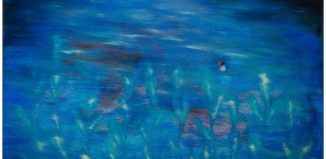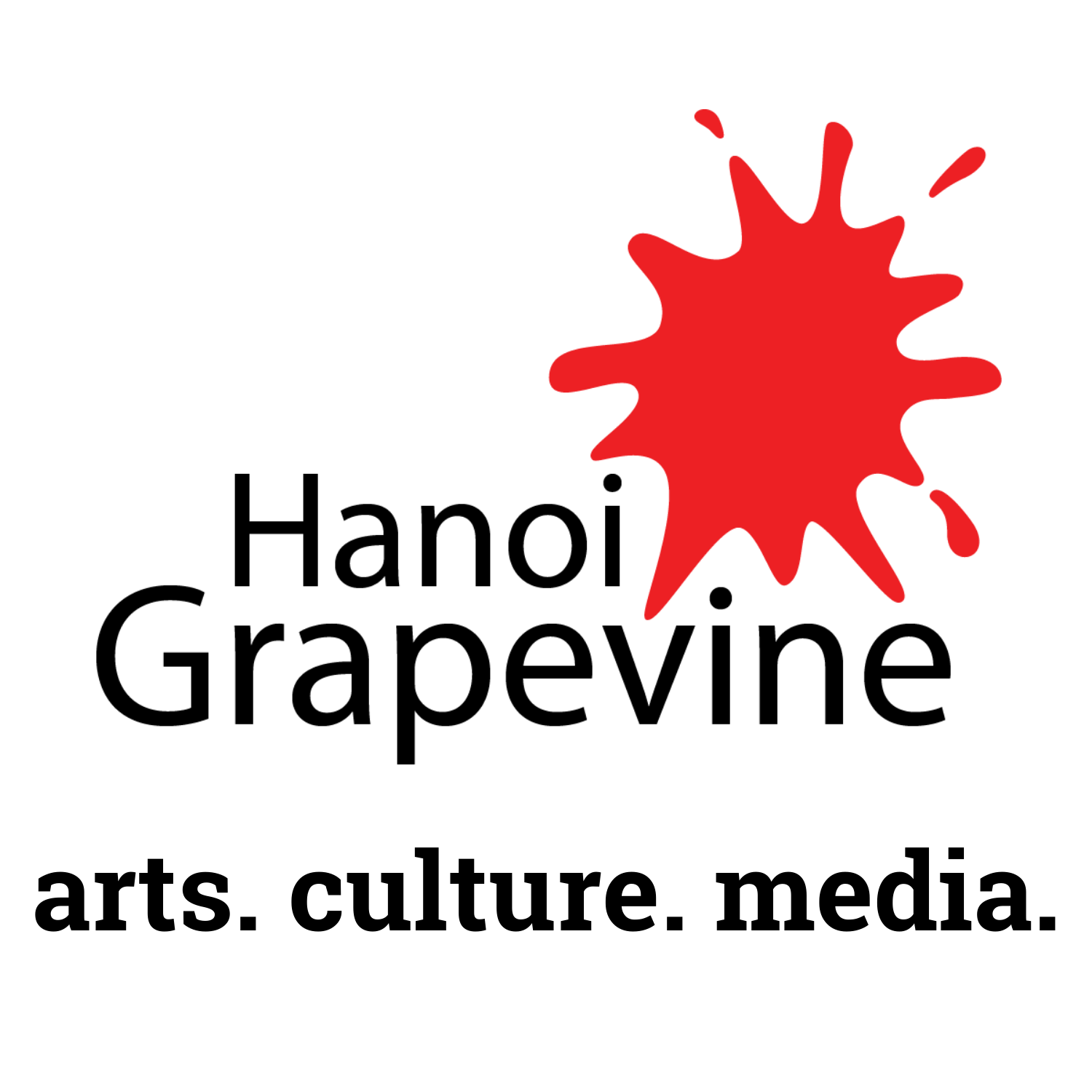”Another Crossing” by Bao Vuong – A quest for hope in the dark ocean
Written by Ut Quyen for Hanoi Grapevine
Please do not copy or re-post without permission
The exhibition “Xuyên” (“Another Crossing”) by Bao Vuong (on display at Manzi until 5 July) is the artist’s quest for his own origins, about the unspoken parts in the family history, his effort to re-experience the past, and to connect himself with the broken links in family relations – with his parents, who are filled with painful memories they always locked in their hearts.
However, to enjoy this exhibition, you do not necessarily need to know the story behind it. Because the works themselves are visually strong enough to give viewers many layers of emotions: tension, yearning, despair, yet at times as beautiful as an anthem.

Entering the 1st floor space of Manzi, the audience are welcomed by three oil paintings on wooden boards, including the series Xuyên XIII consisting of 4 paintings named Đêm (Night) numbered from 1-4, then Xuyên XI and Xuyên VII. With only black paint applied onto the wooden board with rough strokes, you will be amazed at the rich expression these paintings can bring. If anyone ever sits on the riverbank, watching at the waves rolling, would understand the feeling of just forgetting the surrounding environment, focusing completely on the rippling waves, you would imagine the shore turning into a boat sailing off. And in the same way, once you lay your eyes for long enough on Bao Vuong’s paintings, you will see the waves, “frozen like a scar that does not heal”, starting to move. If you find yourself suck into that world, even the sound of the ocean comes to life. And you will be drawn into that world, surrounded by immense waves, and you begin to feel that despair, having spent four nights disoriented at sea, remembering nothing else but the ever-rumbling waves.
Only those who have been traveling the ocean on long journeys can understand its beauty, magnificence, and destructive power. That beauty and power both make us fall in love, but at the same time afraid to the point that you want to flee. Bao Vuong’s three forementioned works have the ability to fully and honestly give viewers that feeling without any caption attached.
However, if you know more about the context of these work, you will explore a deeper level of emotions. The three Xuyên are three different views of the ocean. The Đêm series is a close-up view of the waves in the ocean, when calm, when rumbling. Then with Xuyên VII, the audience is surrounded by the horizon where the vast sea meets the sky. Xuyên XI then represents a central perspective and is completely different from the previous two works in terms of techniques. Instead of applying thick paint layers of paint on the surface of the wooden board, in this work, the artist first covered the board in black paint, then used the painting knife to make sharp slashes on the surface. At a certain perspective, these marks look like waves in the vast ocean. And then at another point of view, they are numerous refugee boats floating one after another at sea. These knife marks also show the act of crossing the border, an irrevocable decision, an act of no turning back, a separation with family, with friends, home, with the past of oneself.

Two paintings displayed in the space on the second floor of Manzi are the only works in the Xuyên series that have a ray of hope. The circular Xuyen XIV with a slight glimpse of the sky at the corner, yet it is striking on the background of gold leaves and cloud lines. That bright golden sky, according to the artist, shows the dream of refugees, when it seems like the destination is right in front of you yet stand between are an ocean of obstacles. Even so, it is the golden sky in this work that could be an annoyance when it brings a sense of decoration, breaking the pattern of monochrome and minimalism of other works in the exhibition. Emotions splashing from the black ocean waves seem to be block by the horizon separating it from the calm golden sky.

Xuyên “Trắng” (“White” Crossing) also speaks of hope, but is a hope of the heart, not of the mind. The painting, as the name implies, uses only pure white paint, with different surface treatment methods: on the upper half, the color lays flat on the surface representing the sky; in the middle part there are large streaks of palette knife resembling the sky at dawn, or the lines of land over the horizon; and with the lower half, the artist create a textured surface that give out the feel of the sea. If black representing the night sea seems quite close to reality, a pure white dawn is unreal. In this picture, all the sensations of color and human senses seem to be distorted. That might be the way Bao Vuong express the flame of hope that flared up in one’s heart like the dazzling white light that could overpower all colors and shapes.

Xuyên XIV and Xuyên Trắng were arranged on the second floor because this is where Bao Vuong performed “Nước” (Water), going through 4 nights and 5 days without food, water, except for rainwater. For many people, this performance is just an act of self-mortification. As for Bao Vuong, this is a necessity to help him recreate the what his family and 200 other people had gone through crossing the border on a boat that year. In that situation, “without hope, people cannot survive,” said the artist. When he was put on the boat, Bao Vuong was less than a year old. In his mind there were no memories of a “boat person”. But still those hard days of despair inscribed in his body. The performance had to stop after the third night because the artist was exhausted in the harsh summer heat without a single raindrop in Hanoi. This is the first and the last time it was performed, “Because such experiences, people only need to go through one once in their lifetime,” said Bao Vuong.

If stand alone, not all the artworks in the exhibition “Xuyên” may satisfy all the demanding audience. But as a big picture, putting them together is a solution to help viewers balance their emotions while walking through the entire exhibition space. If there were no gleaming of hope pulling them back, the despair of the deep dark nights in the ocean would weigh down everyone’s heart long after they have left.



Translated by Hanoi Grapevine













